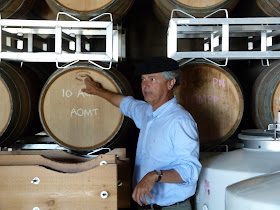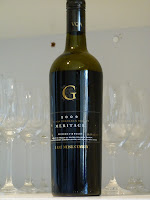
Photo: Vineyard at Averill Creek with bird netting
It takes a few years for a wine festival to establish itself.
The Okanagan Wine Festival was a modest affair for about a decade after being created in 1982. Now it consists of four festivals a year, culminating in the 10-day-long fall festival that ends each year on Thanksgiving. It draws thousands of wine tourists and tasters to the Okanagan each year.
The Cowichan Valley Wine & Culinary Festival has just completed its seventh festival. Also quite modest when it began, it has started to attract crowds to the wineries of the Cowichan Valley. The festival still has untapped potential for development but a good start has been made.
The festival idea also has been picked up elsewhere. This weekend, there is an inaugural food and wine festival on Salt Spring Island, even though the island has only three wineries. However, they all have good wine and the island has many culinary treasures.
In the Cowichan Valley, this year’s festival included launch of a number of wines and the opening of Unsworth Vineyards, the valley’s newest winery. It is located at 2915 Cameron-Taggart Road, Mill Bay.

Photo: Tim Turyk
The winery has been launched by Tim and Colleen Turyk, who were first attracted to the region because they have had a summer home in nearby Shawnigan Lake and their son, Christopher, worked for a time in Amusé Restaurant in that community. That fired an interest in both food and wine to the point of developing the winery and persuading the restaurant to relocate to the winery property.
Born in Victoria in 1951, Tim started a career in fishing through a summer job in a Prince Rupert packing house while he was completing an economics degree at the University of British Columbia. In 1972, Tim bought a boat and spent the next four years as a commercial fisherman. His partner was Colleen, whose father was in the fishing business as well. In 1978, with his father-in-law, he founded Bella Coola Fisheries, based in Delta, now the fourth largest fish packer on the coast. Now he is easing into a new lifestyle.
Unsworth Vineyards is on a 13-hectare (32-acre) farm not far from Shawnigan Lake and within sight of the Merridale Estate Cidery. A previous owner had planted about a hectare of Maréchal Foch in 2006 but sold the property to Tim just as the vines were producing a first crop. There is a substantial area of new plantings there as Tim and Daniel Cosman, the winemaker, ramp up the business.
Unsworth (it is an old family name) opened with two wines. The Pinot Gris 2010 is fresh and crisp, with aromas and flavours of citrus (88 points). Symphony 2009 is a blended red, equal parts of Merlot and Cabernet Libre. Deep in colour, the wine begins with the dusty, smoky aroma typical of Cabernet Libre. On the palate, the rich, sweet berry flavours of Merlot take over (88).
Tasting room guests were also given samples of Ovation, the winery’s port-style wine. That wine is not ready to be released yet, as Tim acknowledged, because it needs time in barrel and bottle for the fruit and the spirits to knit.

Photo: Andy Johnston and his wine releases
Averill Creek’s Andy Johnston also used the occasion of the festival to release new vintages, beginning with the Averill Creek Pinot Gris 2009. The wine, which is barrel fermented, begins with spicy aromas and offers a rich palate packed with fruit flavours – pear, peach and apricot. The winery has released 1,200 cases at $20 a bottle (90 points).
Averill Creek Foch Cabernet Reserve 2009 ($39.99) is a dark, swaggering blend of 65% Maréchal Foch and 35% Cabernet Foch (the latter, like Cabernet Libre, is a Blattner hybrid). The wine has ripe flavours of figs and black cherries, with a rustic undertone of olives and even earth. It is rich and round on the palate and altogether satisfying (90).
Averill Creek Pinot Noir 2009 ($26 for 1,300 cases). This variety is the flagship at Averill Creek and this wine is from a good recent island vintage. The wine has vibrant fruit, with notes of strawberry and cherry and with the classic Pinot Noir texture (89).
Averill Creek Pinot Noir Reserve 2009 ($60 for 200 cases). This wine was made from grapes that were allowed to hang on the vines an extra two weeks because the fermenter was already full. It was a really fortunate accident. This dark wine begins with an appealing aroma of spice and cherry. On the palate, it is rich in texture, with flavours of black cherry and mocha and with spice on the long finish (92).

Photo: Xavier Bonilla
At Cherry Point Estate Wines, owners Xavier and Maria Bonilla started guests to a winery dinner with glasses of Cherry Point Ortega-Siegerrebe 2010 (88 points), a blend that combines the fruity flavours of the Ortega with the elevated aromatics of the Siegerrebe.
At that time, the winery released its latest take on Cherry Point Bête Noir, a label created four or five years ago for a big, full-bodied wine made with the Agria grape. The current release is quite a different interpretation, being a blend of 2007 Pinot Noir, 2009 Agria and 2009 Castel. Xavier says the wine reminds him of a Rioja red with its earthy berry and oaky aromas and its mature flavours.

Photo: Jeff MacLeod
At 22 Oaks Winery near Duncan, Jeff MacLeod also had new releases. The 22 Oaks Pinot Gris 2010 is made in a style that reminded me of New Zealand Sauvignon Blanc. By leaving the juice on the skins for two days, Jeff extracted vivid aromas and flavours of lime and lemon. The bright acidity gives the wine a refreshing finish (89).
He also had a blend called 22 Oaks Drink You Pretty 2010. It is a blend of Chardonnay and Pinot Gris. It is a wine with citrus flavours and a texture of minerality to give it a firm structure (88).

Photo: Roger Dosman
Alderlea Vineyards rarely opens its tasting room. However, Roger and Nancy Dosman opened the doors to the benefit of festival wine tourists. The releases included Alderlea Pinot Gris 2010 ($21), a lovely wine with notes of grapefruit and peaches and with a bright and crisp finish (89).
Alderlea Pinot Noir Reserve 2007 ($35) has the fullness of a maturing wine on the palate, with flavours of cherry and spice (90)
Alderlea Clarinet ($26) is the winery’s first-rate Maréchal Foch, a big, juicy red with flavours of cherry and plum, and with the touch of smokiness on the nose and finish that this variety sometimes gives (89).

Photo: Brock Windsor sabering a bottle of bubbly
The numerous dinners around the Cowichan Valley during the festival also showcase the region’s wines. I was fortunate to be at the Stone Soup Inn near Lake Cowichan where chef Brock Windsor paired five wines with exceptional food. In the few years that Brock has had this restaurant (and B&B) open, his food has been acclaimed across the country.
He built his dinner around five excellent island wines. Venturi-Schulze Brut Naturel 2008, which accompanied a salad, is as fine as Champagne. (Why do we not see more island sparkling wines?). Brock added to the appeal by sabering four bottles for his guests.
A chanterelle and corn soup was paid with Rocky Creek Ortega 2010. The Ortega grapes is one of the most reliable varieties for the island. Rocky Creek captures its citrus and melon flavours in its dry version.
Smoked salmon was paired with Blue Grouse Pinot Gris 2008. This winery is recognized by its peers for producing an elegant Pinot Gris, with a fine core of sweet fruit on the palate and a dry finish.
Tenderloin of beef was paired with Averill Creek Pinot Noir 2008. This vintage is a little fuller than the 2009, at this stage in its evolution.
Poached pear was put beside Alderlea Hearth 2005, a very satisfying Port-style wine.
I did not score the wines during dinner (how geeky do you think I am?) but there is nothing there under 90. Ditto for the cuisine.





























